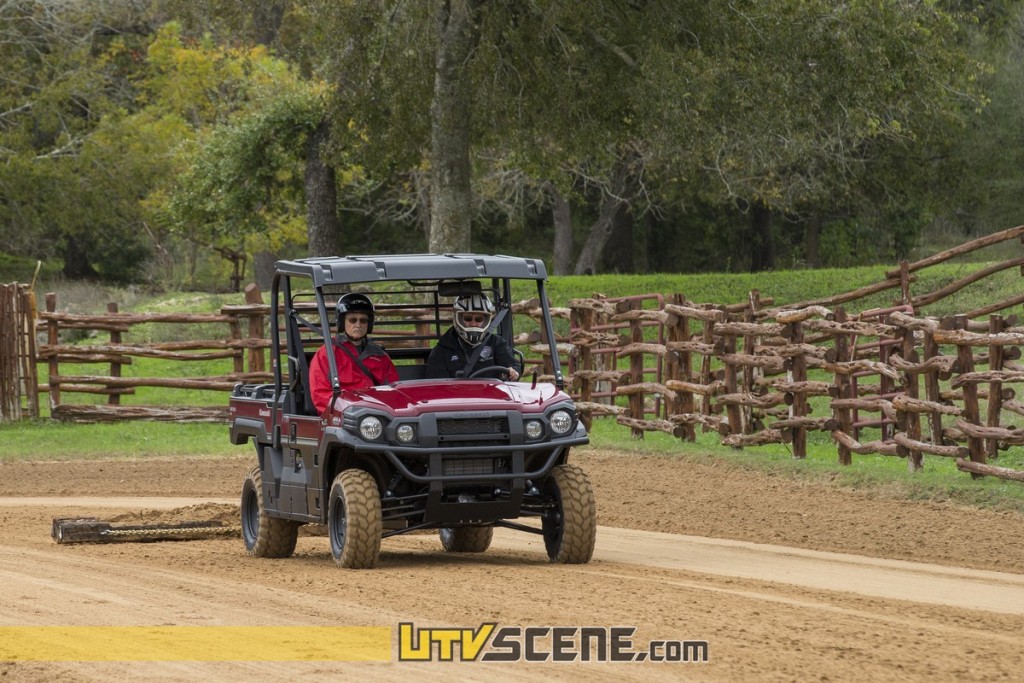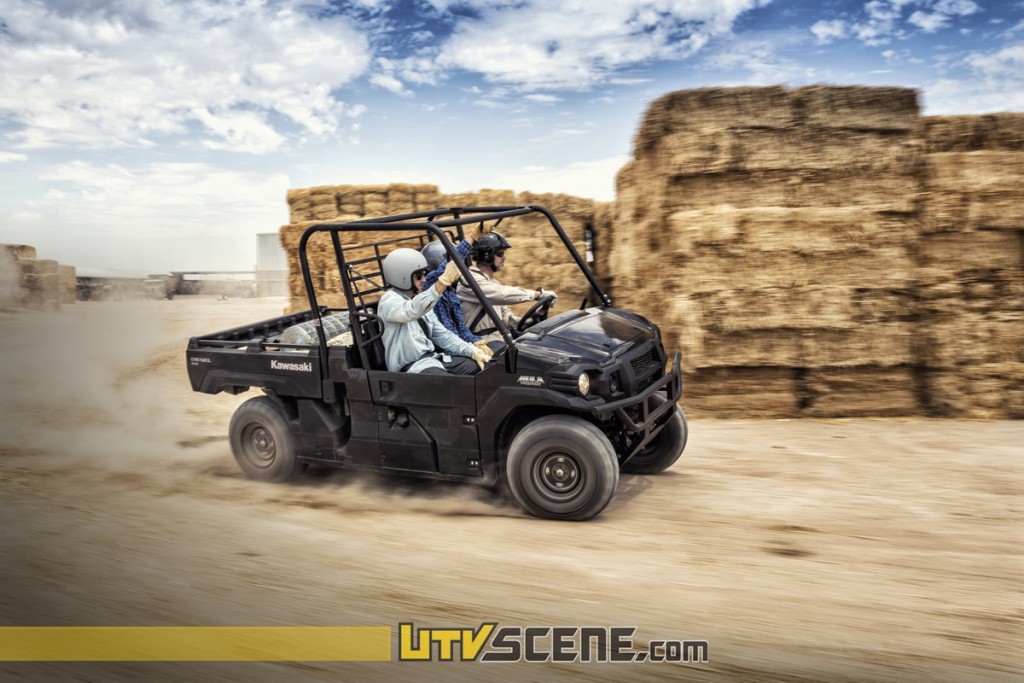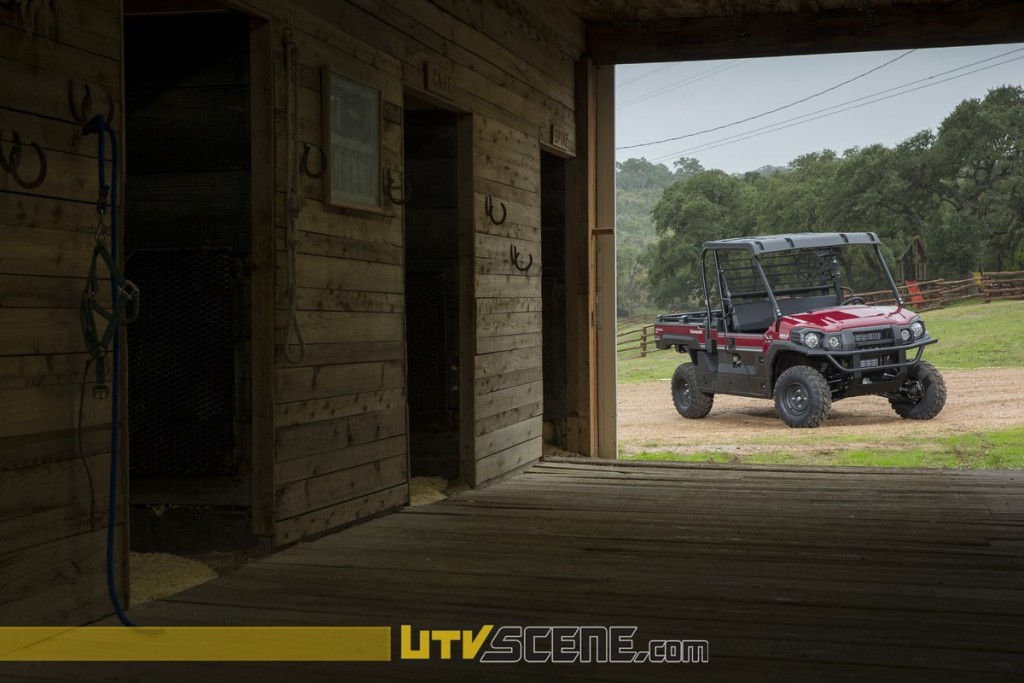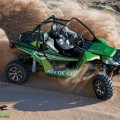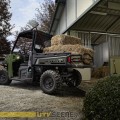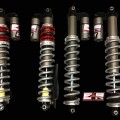2016 Kawasaki Mule PRO-DX and DXT Review
- Updated: November 24, 2015
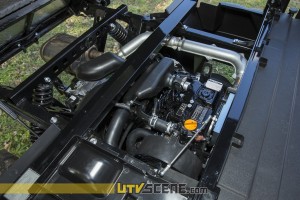 The 2016 Kawasaki MULE PRO-DX and DXT side x side uses a Yanmar 993cc three-cylinder diesel engine that delivers 38 foot pounds of torque at only 2400 RPM. It fires as fast as you can turn the key, and when it does, there’s no mistake that the DX uses a diesel-powered engine. After testing the machine I can confirm that the DX makes power that’s ideal for hauling heavy loads. What’s more the way it handles these loads impressed me. The cable-assisted accelerator allows responsive and controlled acceleration without any jerky feeling, this is especially appreciated when backing up to hook up to a trailer. The drive is accomplished with a CVT system that features Kawasaki’s most durable belt, it’s said to be four times stronger than the belt used in their Mule 4010 Series. The CVT allows natural engine braking on gradual slopes to reduce operator fatigue and extend the life of the brake pads. I noticed engine braking works best in Low, if you’re in High mode engine braking won’t come on until you put some pressure on the accelerator, this takes a little getting used to.
The 2016 Kawasaki MULE PRO-DX and DXT side x side uses a Yanmar 993cc three-cylinder diesel engine that delivers 38 foot pounds of torque at only 2400 RPM. It fires as fast as you can turn the key, and when it does, there’s no mistake that the DX uses a diesel-powered engine. After testing the machine I can confirm that the DX makes power that’s ideal for hauling heavy loads. What’s more the way it handles these loads impressed me. The cable-assisted accelerator allows responsive and controlled acceleration without any jerky feeling, this is especially appreciated when backing up to hook up to a trailer. The drive is accomplished with a CVT system that features Kawasaki’s most durable belt, it’s said to be four times stronger than the belt used in their Mule 4010 Series. The CVT allows natural engine braking on gradual slopes to reduce operator fatigue and extend the life of the brake pads. I noticed engine braking works best in Low, if you’re in High mode engine braking won’t come on until you put some pressure on the accelerator, this takes a little getting used to.
The diesel engine features a pre-combustion chamber, improving the mixing of air to fuel for improved engine performance and fuel mileage, I was told you can look forward to 10% better fuel mileage compared to the Mule PRO FX. It starts every time even in the cold with the assistance of glow plugs. Dash-mounted switches are well placed and easy to use. You can instantly engage the systems, giving full control over the 4WD and locking rear differential. The dual mode on the rear differential allows it to be fully locked for maximum traction, and when unlocked it acts as a “turf mode” minimizing the vehicle’s impact on the terrain.
In total there are six versions of the new diesel-powered Mule PRO. My favorite is the DXT. The T stands for Trans Cab as it allows you to easily transform your three-person machine into a six person one. The patented idea is quite clever. Not only can one person make the transformation in less than one minute without any tools, but even in six-person mode the gas-assisted dumping cargo bed is still available!
We only tested power steering models, and I would highly recommend you do whatever it takes to upgrade to EPS. If you do you’ll agree with me when I say steering is best in class, and one of the most notable things I enjoy about the Mule PRO series. Easy one finger effortless steering assistance is provided at low speeds, this compliments the Mule’s extremely tight turning radius of only 16 feet. The power steering stiffens at higher speed providing a controlled feel through the wheel, and the Mule PRO’s EPS system also absorbs the energy that happens when a front wheel hits a rut or rock, so you’ll never feel the kind of thumb-breaking or wrist spraining blow that you would if you didn’t spend the extra $800 for EPS.
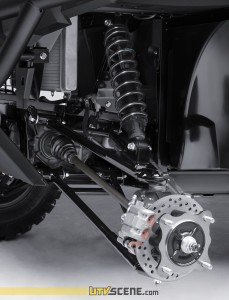 If speed is just as important as getting the job done for you, you might opt for the gas-powered Mule PRO FX or FXT. My top speed was only 30mph, while the FX travels at a much faster speed of 45mph. The 26” Duro tires performed well in the dry conditions that we tested in, With their flat lugs noise was minimal, which is nice for a vehicle like this that may be used a lot on small paved roads, fire roads, driveways, hard-packed trails etc.
If speed is just as important as getting the job done for you, you might opt for the gas-powered Mule PRO FX or FXT. My top speed was only 30mph, while the FX travels at a much faster speed of 45mph. The 26” Duro tires performed well in the dry conditions that we tested in, With their flat lugs noise was minimal, which is nice for a vehicle like this that may be used a lot on small paved roads, fire roads, driveways, hard-packed trails etc.
Stopping the Mule is done with hydraulic disc brakes on each wheel. I’m so happy there’s no low cost drum or axle brake system on this machine. It’s a premium working-class side-by-side and deserves its premium brakes. With this Kawasaki opted for dual-piston calipers that are paired with big 212mm rotors up front while single-piston calipers in the rear provide excellent stopping power.
